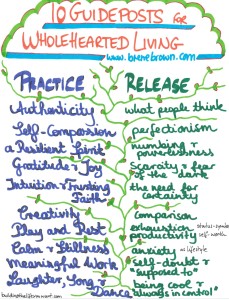How to Strengthen Our Bonds
 As human beings, there are certain things that we require in order to live healthy, happy lives. We require food and drink for sustenance, sleep and exercise for physical stamina, and daily commitments for a healthy mind. It does not end there, however. We are hard-wired to crave emotional connection with others, and to belong to one another. Emotional connection is a basic human need. Our need for belonging can often go unnoticed or minimized in comparison to our day-to-day responsibilities. And in stressful times, our bonds can be the first thing to go! However, keeping strong bonds with one another is essential to living out healthy and happy lives.
As human beings, there are certain things that we require in order to live healthy, happy lives. We require food and drink for sustenance, sleep and exercise for physical stamina, and daily commitments for a healthy mind. It does not end there, however. We are hard-wired to crave emotional connection with others, and to belong to one another. Emotional connection is a basic human need. Our need for belonging can often go unnoticed or minimized in comparison to our day-to-day responsibilities. And in stressful times, our bonds can be the first thing to go! However, keeping strong bonds with one another is essential to living out healthy and happy lives.
In psychology, the term ‘attachment’ often causes us to think of the bonds formed between babies and caregivers, as defined by John Bowlby decades ago. However, our need to attach to others remains throughout our lifetime. In modern psychology, adult attachment refers to emotional engagement, attention and responsiveness (Johnson, 2004, p. 33). Our need to reach out to others and feel connection and belonging remains well into adulthood, and our sense of well-being is intertwined with the strength of our bonds. The following tips can give us the help we sometimes need to keep our bonds strong and our connections open and flowing.
[Incorporate vulnerability.] Vulnerability is one of the least pleasant feelings to experience, and yet it can do the most good for our relationships.  One easy tip to practice more vulnerability in our relationships is to simply change the type of conversations we have. When we spend a little more time admitting the honesty of our feelings with those we love, it often engages others and draws them in closer. It is possible, however, that some of our loved ones are not yet equipped to respond well to our vulnerable moments. If we choose to risk vulnerability with someone who responds poorly, we might begin to build even more walls. Therefore, it can help to notice those who respond to our feelings with empathy and care. We can then choose who we want to risk vulnerability with. Vulnerability researcher Brene Brown has written countless books on this very subject, and offers guideposts on how to embrace vulnerability daily. Finally, we must learn to recognize when others are risking vulnerability and work to be emotionally accessible and responsive. This is equally as important in strengthening bonds.
One easy tip to practice more vulnerability in our relationships is to simply change the type of conversations we have. When we spend a little more time admitting the honesty of our feelings with those we love, it often engages others and draws them in closer. It is possible, however, that some of our loved ones are not yet equipped to respond well to our vulnerable moments. If we choose to risk vulnerability with someone who responds poorly, we might begin to build even more walls. Therefore, it can help to notice those who respond to our feelings with empathy and care. We can then choose who we want to risk vulnerability with. Vulnerability researcher Brene Brown has written countless books on this very subject, and offers guideposts on how to embrace vulnerability daily. Finally, we must learn to recognize when others are risking vulnerability and work to be emotionally accessible and responsive. This is equally as important in strengthening bonds.
[Gain insight into the self.] Practicing self-awareness will always be an asset to emotional health. To know oneself means to know ones strengths and limitations, and to know ones potential woundedness, as well. Our limitations, though uncomfortable to experience, serve as a beautiful access point for others to connect with us. We can also practice mindfulness of our moment-to-moment emotional state, and use our insight for more guided navigation in our relationships. Attachment theorist, Sue Johnson, points out that fear and uncertainty activate attachment needs. What this means is that when we are under duress, our need for connection grows even stronger. We can use this knowledge to our benefit by working to skillfully reach for support when we are most in need of it. Finally, we must not forget to love ourselves and others, even when the going gets rough. Brene Brown shares, “How much we know and understand ourselves is critically important, but there is something that is even more essential…: loving ourselves.”
[Lean into discomfort.] When we are able to find comfort in one another, it feeds our need for connection beautifully. In moments such as these, we can build on our experience. For example, we can notice when someone responds to us with empathy and intentionally thank them for their support. When we tell others how much their support means, we increase the likelihood for connection to occur again – thus strengthening the bond. We can also experience great discomfort in reaching out – especially if we are not responded to well. However, never fear the discomfort! It is in our least comfortable moments that we can do the most growing. The most important thing to realize is that our goal is to be connected, which might sometimes not involve instant comfort. However, comfort will grow with practice in the presence of empathy and compassion! Brown says that “vulnerability sounds like truth and feels like courage. Truth and courage aren’t always comfortable, but they’re never weakness.”
In the process of strengthening our ties to one another, it is imperative to see the work we do through the lens of love. When our bonds are stressed, when we feel the pangs of disappointment, when our efforts towards vulnerability are thwarted – we need not be distracted from our purpose – love. We are not pursuing just any type of connection, we are pursuing loving connection. And we are fighting for the love in our lives, which will inevitably involve struggle, discomfort and frustration. We can thank these growing pains for the loving ties we have!
Johnson, S. M. (2004). Creating connection: The practice of emotionally focused couple therapy. New York, NY: Routledge.
M.A., LMFT-Associate, LPC-Intern
Supervised by Dr. Amy Fuller, LMFT-S, LPC-S









